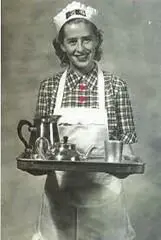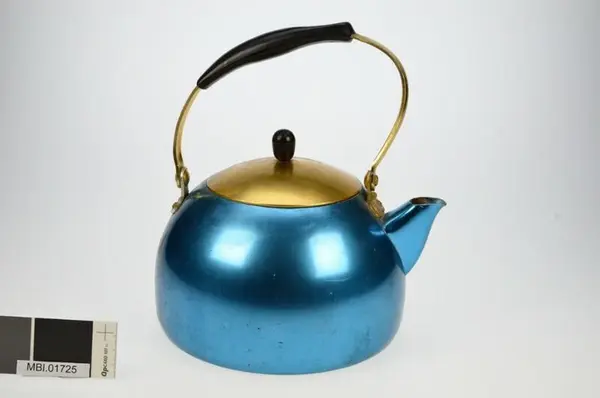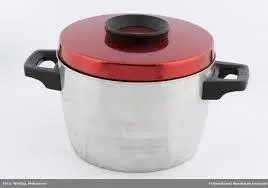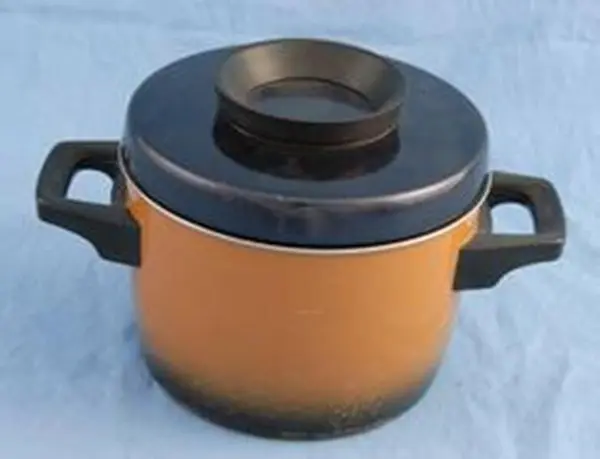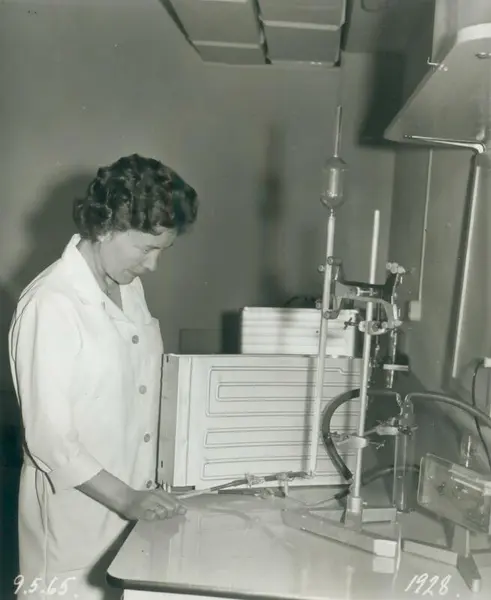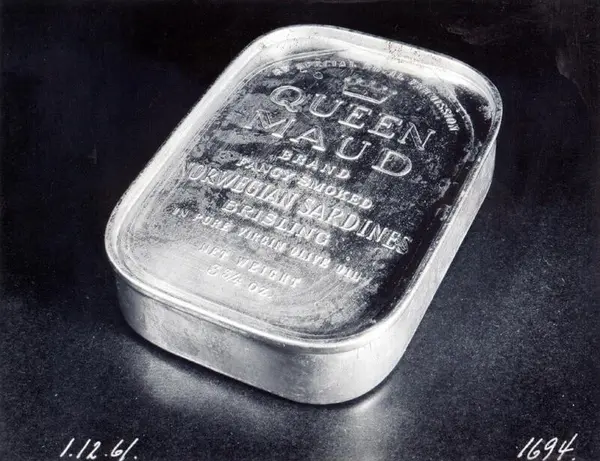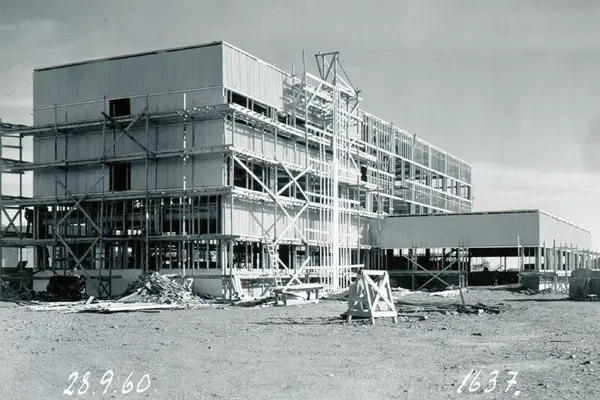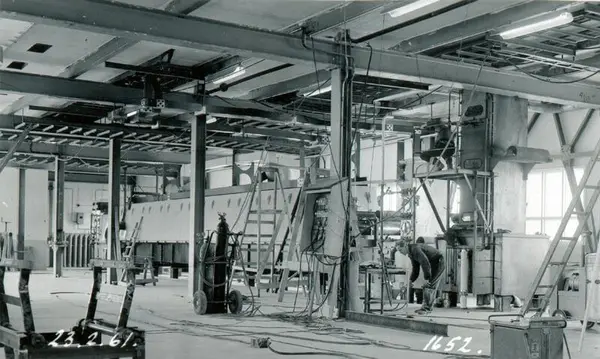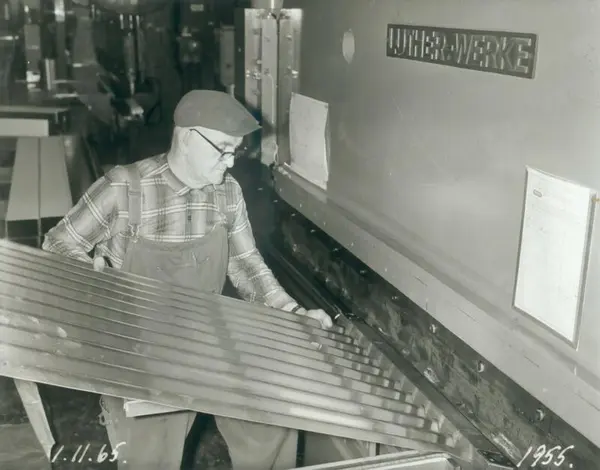-
Edited photo of "The Høyang Girl" from the advertising department of A/S Nordisk Aluminiumindustri.
New markets and focus areas
The German occupation force laid the foundation for an expansion of the Norwegian aluminum industry after the war. The commenced German plant in Årdal was completed in 1948 under the auspices of the state. It was named Årdal Verk. Furthermore, Norway's largest smelting plant, Sunndal Verk, was established in 1951 with the help of the US authorities and the Marshall Plan. The state-owned plants were later merged and were named Årdal and Sunndal Verk (ÅSV). While ÅSV focused on export-oriented metal production, Norsk Aluminium Company (Naco) concentrated on metal production and further processing for the domestic market at the subsidiary A/S Nordisk Aluminiumindustri (Nordisk) in Holmestrand.
After the war, there was a shortage of goods and the demand for aluminum products rose greatly. The recovery policy facilitated the creation of new markets for light metal products. In addition to kitchenware, there was a great demand for electric cables and plates for the transport and construction sectors. Between 1945 and 1950 the factory in Holmestrand therefore expanded both in terms of area and production. The kitchen department doubled its capacity for canned materials accelerated and the rolling mill's capacity increased greatly.
A new coffee boiler is launching
The factories' own design offices were strengthened around 1950 by entering into agreements with external designers, called "utility artists", who came from professions that were outside the aluminum production community.
They were architects, goldsmiths and other craftsmen. Il-O-Van in Moss received help from the country's first industrial designer, Thorbjørn Rygh, to design their new coffee boiler. It was named "the pour-over kettle" and proved to be the biggest market success for aluminum coffee kettles ever in Norway.
- 1/1
The pour-over kettle designed by Torbjørn Rygh. Photo: Moss by- og industrimuseum/Digitalt museum.
The young designer Tias Eckhoff designed a coffee boiler for Halden aluminum commodity factory, while the experienced goldsmith Oskar Sørensen, who worked for the goldsmith company Tostrup in Oslo and taught at the Norwegian National Arts and Crafts School, was commissioned to design many types of kitchenware for Nordisk.
His most famous product is the casserole set Høyang Extra, later called Høyang Luxus.
- 1/2
Høyang Extra (1964). Photo: Digitalt museum - 2/2
Høyang Luxus (1970). Photo: Digitalt museum.
-
Testing of refrigerator evaporators in 1965.
An introduction of aluminium foil and cooling technology
He also designed several coffee pots, saucepans, jugs, pitchers and specialty items for the Holmestrand company. But none of the products achieved the same sales success as the Il-O-Van pour-over kettle in Moss. The success helped Il-O-Van concentrate its production even more on kitchenware, while Nordisk invested in other areas as well.
Aluminum foil was introduced in the market, and the development of the cooling technology made so-called "roll-bond", refrigerators and freezers evaporators, an important focus area for Nordisk. When the demand for kitchenware leveled off in the mid-1950s, the finished goods department concentrated more on the products for refrigerators and freezers and eventually also car parts and rims for Volvo, Saab and Porsche in the 1960s.
A growing canning market
Nevertheless, the canned food market grew the most. Anodizing the canned strips had come a long way in solving the problems of using aluminum as a food packaging, but not completely. Through the Canadian part owner Alcan, after the war, Nordisk gained access to the Alulabs research laboratory in England. The laboratory had the most modern technology of intermediate products at the time, and as early as 1948 succeeded in further developing the Norwegian anodizing process.
Anodized aluminum strips combined with new Swiss paint methods and a special alloy proved to be the "final" solution to the 30-year-old "canned matter". The coating process of strips for the canning industry was called "con-ano-lac" and was first implemented in Holmestrand. The process made it possible to paint strips to withstand high acidity foods, and Nordisk could now supply strips to all aluminum industry products.
- 1/1
Sardine can in pressed aluminum.
The acquisition laid the foundation for a major expansion of the factory in Holmestrand. In 1960, Nordisk bought a 60-acre site at Vesthøy outside the city. Here, a prestigious strip coating plant and a wire rolling mill for electric cables were erected
- 1/1
From the development at Vesthøy in 1960.
The new and more efficient lacquer process also made it possible to lacquer aluminum strips on both sides in one and the same operation, something no other factory in the world was capable of.
In collaboration with Alulab's and other foreign research communities, Holmestrand engineers further improved the process, reducing energy consumption and improving the quality of the materials.
- 1/2
From the development at Vesthøy in 1960. - 2/2
From the paint factory at Vesthøy in 1961.
More effective production methods
The new anodized and lacquered alloys combined with low weight proved to be suitable for several of the Alcan Group's focus areas. Together with Naco, they could now focus on materials for the electrical, transport, and construction industries. It turned out that the lacquer used for canning materials was also very weather resistant, and that it could therefore be used for surface treatment of building materials. In 1962 Nordisk tested out the facade product Høyang-panel.
Lacquered strips were pressed out into wall, ceiling and acoustic panels for commercial and agricultural buildings. The Norwegian knowledge was crucial for aluminum to gain ground in even more areas. Within the intermediate products, in the mid-1960s, Nordisk was more advanced and vital than ever.
- 1/1
Cracking of roof panels in 1965.
Today, aluminum is an important material in building technology, especially with regard to use in load-bearing constructions in building structures, but also with regard to indoor installations and designs. Building materials are today the core business of Hydro Holmestrand.
